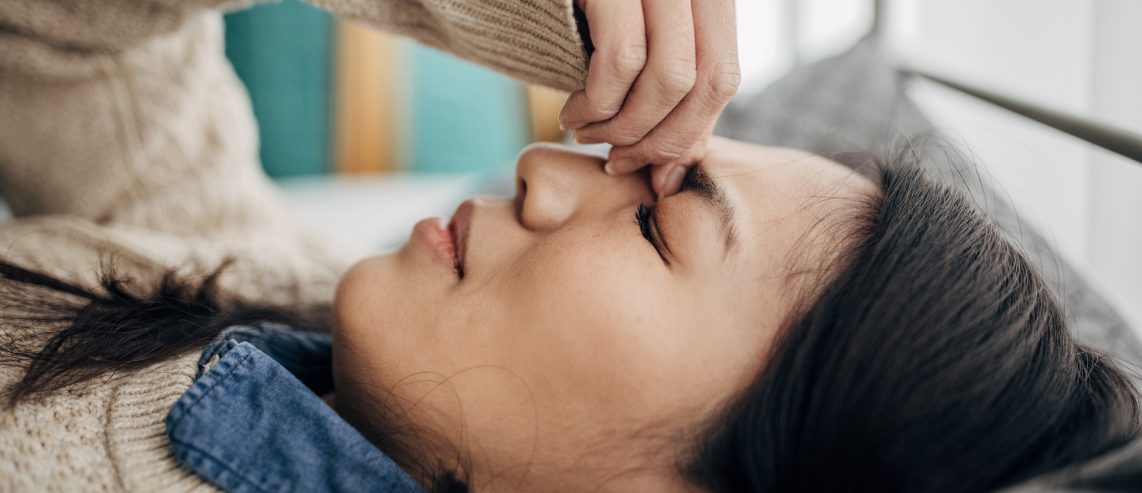Weather changes often signal the start of a storm coming. They may also signal a new season.
For some people, weather changes may trigger a headache or migraine. They may also make your headache or migraine worse.
Why, how, or if weather changes can trigger headaches or migraines or make them worse is still not clear.
What are Weather Triggers?
More than a third of people with migraines say weather changes impact their pain. More than half of people getting treatment for severe migraine at a headache clinic said that weather changes triggered some attacks.
According to the American Migraine Foundation, weather-sensitive people may get headaches or migraines during:
- Extreme hot or cold weather.
- Storms and lightning.
- Weather with bright light, such as hot, sunny days.
- High humidity.
One study found that people with chronic pain, including migraines, reported having the most pain on days with:
- Below-normal air pressure.
- Higher precipitation.
- Above-normal relative humidity.
- Stronger winds.
Never Miss a Beat!
Subscribe to Our HealthBeat Newsletter!
Thank you for subscribing!
You can now select the specific newsletters you'd like to receive.
You are already subscribed.
Subscribe to more newsletters in our email preference center.
Sorry, an error occurred. Please try again later.
Get Healthy Tips Sent to Your Phone!
What Is Barometric Pressure?
Changes in air pressure cause changes in weather. Air pressure is also known as atmospheric or barometric pressure. Air pressure readings help predict future weather.
A rapid drop in air pressure means a low-pressure system is on the way. A low-pressure system has no energy to push clouds or storms away. So, a drop in barometric pressure may bring cloudy, rainy, or windy weather.
A rapid rise in air pressure pushes away clouds and rain. A rise in air pressure means cool, dry air and clear skies.
The air pressure also changes with altitude — the vertical distance from sea level. Some people may get headaches in higher altitudes, like the mountains. As the altitude rises, air density is lower, so there’s less air pressure.
Studies on air pressure and headaches don’t show that weather changes are the only trigger for pain. And they can’t explain how weather changes affect your body. The study on chronic pain and weather changes found people often have other health problems that can add to their pain.
The same is true for people with migraine. They often have many things that can trigger migraine symptoms. Sensitivity to weather changes is one of many triggers.
So, it’s hard to figure out what causes any given migraine.
Different weather changes also affect people in different ways. People with migraine may feel weather changes more or in a different way than those with tension-type headaches.
Unless the weather change is dramatic, it’s unlikely to cause a migraine, according to the American Migraine Foundation. The weather change may mix with other triggers to cause an attack.
What Does a Barometric Pressure Headache Feel Like?
Whether weather changes trigger headaches or migraines, the symptoms are the same. That’s true whether these triggers act on their own or mixed with another trigger.
Tension-type headaches are the most common type of headache. Symptoms of tension-type headaches include:
- A steady ache that is usually mild to moderate in your head, face, or neck.
- Pain that feels like a dull pressure, often surrounding your head.
- Pain that lasts for less than four hours.
- Has no other symptoms.
Migraine symptoms include:
- Moderate to severe throbbing, pounding, or pulsing pain on one side of the head.
- Sensitivity to light, noise, and smells.
- Nausea.
- Vomiting.
- Pain that gets worse with movement, coughing, and sneezing.
- Pain lasts up to 72 hours.
How to Treat Headaches from Weather Changes
No matter the trigger, headache or migraine treatment is the same: Pain relievers and headache medicines.
Many drugs treat headache pain and prevent chronic headaches and migraines. Headache and migraine treatments include:
- Over-the-counter pain medicines to stop the pain. This includes non-steroidal anti-inflammatory drugs (NSAIDs). For instance, ibuprofen (Advil or Motrin) or naproxen sodium (Aleve).
- Prescription pain medicine. This includes a variety of drugs, such as triptans, steroids, and 5-HT agonists.
- Medicine to prevent headaches. This includes beta-blockers, antidepressants, and muscle relaxers.
How to Prevent Weather-Related Headaches
It’s not possible to control weather changes. If the weather changes trigger headaches or migraine symptoms, you can try to plan for the weather.
The American Migraine Foundation suggests taking headache pain medicine before a weather change. You may be able to prevent a headache before the trigger moves in.
You can try long-acting NSAIDs, such as naproxen sodium (Aleve), or long-acting triptan, such as frovatriptan.
But note, there’s no proof that taking these pain medicine works to prevent headaches. And taking pain medicine for too long can lead to rebound headaches. To avoid this, don’t take NSAIDs or Tylenol more than 14 days a month or triptans more than nine days a month.
Focus on triggers you can control. Lifestyle changes can reduce your chances of getting a headache or migraine. These include:
- Get enough sleep regularly. For adults, that means at least seven hours of sleep each night.
- Eat a healthy diet. Don’t skip meals.
- Stay well-hydrated throughout the day. Drink enough water.
- Avoid your food triggers.
- Manage stress.
Common food triggers for migraines include:
- Red wine.
- Caffeine.
- Chocolate.
- Aged cheeses.
- Fermented foods.
- Monosodium glutamate.
When Should You See Your Doctor?
If headaches or migraines get in the way of your daily life, it’s time to see your doctor. “Headaches and migraines are common. It is important to recognize the “warning signs” that would require urgent evaluation by a doctor. You also should be seen if your headaches are increasing in frequency, pain, or are associated with neurological symptoms,” says Alexandra Potock, MD, of Northern Medical Associates-UPMC. They can offer new or better treatment options. You may need to take daily medicine to prevent frequent migraine attacks.
Your doctor may also do a hands-on exam and run some tests. They’ll want to rule out other health issues causing the headaches.
Sources
Weather and Migraine. American Migraine Foundation. Link.
Farbu EH, Rypdal M, Skandfer M, Steingrímsdóttir ÓA, Brenn T, Stubhaug A, Nielsen CS, Höper AC. To Tolerate Weather And To Tolerate Pain: Two Sides Of The Same Coin? The Tromsø Study 7. May 1, 2022. Pain. Link.
Weather Patterns Associated with Pain in Chronic-Pain Sufferers. May 2020. Bulletin of the American Meteorological Society. Link.
Barometer. National Geographic. Link.
Maini K, Schuster NM. Headache and Barometric Pressure: A Narrative Review. November 2019. Current Pain and Headache Report. Link.
Migraine. National Institute of Neurological Disorders and Stroke. Link.
Headache. National Institute of Neurological Disorders and Stroke. Link.About UPMC
Headquartered in Pittsburgh, UPMC is a world-renowned health care provider and insurer. We operate 40 hospitals and 800 doctors’ offices and outpatient centers, with locations throughout Pennsylvania, Maryland, New York, West Virginia, and internationally. We employ 4,900 physicians, and we are leaders in clinical care, groundbreaking research, and treatment breakthroughs. U.S. News & World Report consistently ranks UPMC Presbyterian Shadyside as one of the nation’s best hospitals in many specialties and ranks UPMC Children’s Hospital of Pittsburgh on its Honor Roll of America’s Best Children’s Hospitals. We are dedicated to providing Life Changing Medicine to our communities.

